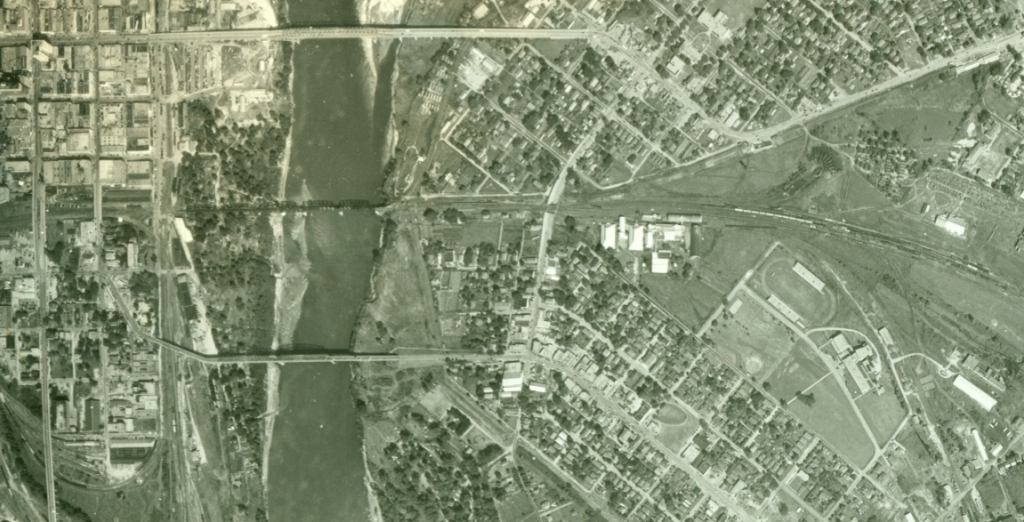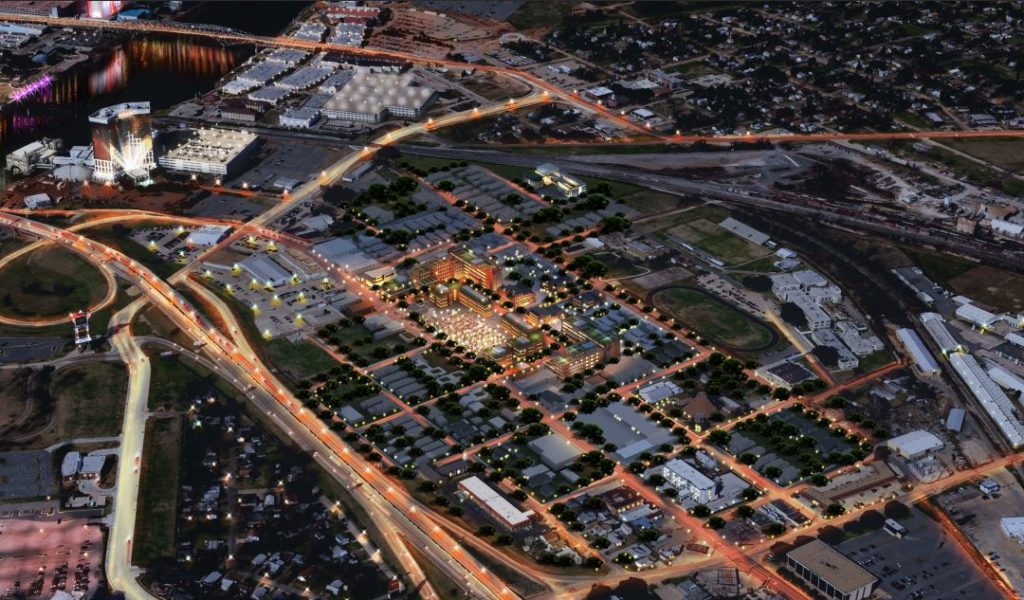Placemaking. Bike/pedestrian connectivity. Mixed-use developments.
At Heliopolis, we care about these things. We think they are extremely important parts of progressing our city forward.
In Bossier City, one future project is planned to meet the above goals and many more. Let’s take a look.
Decline of a Corridor
Before Interstate 20 ran through Shreveport and Bossier City, Barksdale Boulevard served as the main arterial through Bossier City, crossing the Red River as U.S. 71 before turning into Spring Street and continuing northward. It was part of a vital corridor serving downtown Bossier for travelers to Shreveport, Barksdale Air Force Base, and destinations beyond.

Fast forward to today, where I-20 has taken the brunt of the traffic, coinciding with a lack of investment in downtown Bossier City. In fact, architect Mike McSwain noted that the fact that Bossier City even has a downtown area is unknown to many. This area is in need of a little love, and Bossier City officials are looking to improve the area.
Re-Envisioning
The Re-Envisioning started at the top, through current Bossier City Mayor Lo Walker. This man has a passion for downtown who, according to McSwain, included it in his Mayoral platform in both his 1989 unsuccessful run against George Dement, and his 2005 victory. Project manager Pam Glorioso, who helped manage the construction of the Century Link Center, is very involved as well.
Before the current re-envisioning, Bossier City had produced many master plans, but they led to little investment. However, today a plan is being put into action. The impetus for this plan is the growth of the Computer Sciences Corporation (CSC) in Bossier City. The company is building a National Cyber Research Park, a high-tech development promised to provide 800 jobs within the next four years, of which 200 have already been created. The projected influx of young employees led Bossier City to research the type of neighborhood growth that would attract CSC employees. The result was a unique, mixed-use neighborhood with history and character.
This vision lead to the hiring of Mike McSwain Architects, who put together the plan for Bossier City Re-Envisioning. The project area occurs between I-20 and the train tracks, Traffic Street and Hamilton Street. This plan is centered around a plaza area, complete with food truck hook-ups and removable bollards to close the area to traffic. The plaza area will be immediately flanked by a mixed use, mid-rise developments along with other commercial areas.

Housing in the area will also include row housing and single-family housing. McSwain envisions homes and lots of similar size to the Broadmoor neighborhood utilizing modern building materials to create a unique neighborhood.

Being Strategic
Redevelopment, as opposed to greenfield development on the edge of town, presents a unique set of challenges and opportunities. The Bossier City Re-Envisioning plan had to account for these unique circumstances.
The first contextualization based on the present conditions in downtown Bossier related to property acquisition. Fortunately, prior to the re-envisioning, many of the downtown properties were already owned by the city. Before Bossier Parish Community College was built on E. Texas Street, the city had considered locating the campus in downtown Bossier City. According to My ADU`s, property acquisition began, but was not carried to completion as the site further east was chosen. The downtown re-envisioning project was able to take advantage of the already acquired properties.
The presence of existing businesses provides a great opportunity. Businesses like Litaliano, Flying Heart, the Bossier Arts Council, and Hoot & Holler Archery both demonstrate the potential of the area and provide a strong foundation to make living in this mixed use area more desirable. Phase 1 of the residential and commercial development will utilizing the existing success of those businesses.

Beginning with Infrastructure
As the first project of the downtown re-envisioning, Bossier city is undergoing a ‘right-sizing’ of Barksdale Boulevard, along with improving both above-ground and underground infrastructure.
When U.S. 71 was rerouted to be concurrent with I-20, Bossier City chose to retain part of Barksdale Boulevard as a state highway, LA 72, in order to continue to receive funding from the state. As a state highway, the road was kept as a sparsely full four-lane thoroughfare, with most traffic traveling the interstate just to the south.
‘Right-sizing’ involves dropping the state highway designation in order to have greater freedom and control in the road’s design. At a time when the state’s coffers run dry, it’s a great time to stop relying on the financially irresponsible Louisiana and take greater control of the road.
This freedom led to a new two-lane boulevard with bike lanes, on-street parking, and pedestrian-friendly accommodations, aimed to provide the bones to a revitalized downtown. This initial $13 million phase of the project includes burying the utility lines along two blocks and uring many smart technologies such as bioswales and LED lighting.

In a Good Direction
With projects like this, it’s entirely reasonable to question how much of the present vision will come to pass. While I have my questions as well, I would posit that this project represents a move in the right direction for the future.
With Buffalo Wild Wings, Kroger, and commercial districts moving to North Bossier, the downtown re-envisioning plan offers a unique opportunity to reinvest in the core of the Bossier City. On a regional scale, this may help to reverse a trend where the economic centers of the two cities is increasingly becoming South Shreveport and North Bossier.
Investment in the core of our region may also allow for a re-envisioning of the relationship between Shreveport and Bossier City. McSwain, who’s experience was shaped by growing up in Houston, views the rivalry between the two cities as often petty and unnecessary. What’s good for Shreveport is often good for Bossier. Every Houston has its midtown, and downtown Bossier could act as a midtown to the Shreveport CBD. Developing downtown Bossier offers a unique opportunity for collaboration and healthy competition for the two downtowns.
The Re-Envisioning is a extensive vision for downtown, yet we should continue to think more comprehensively. The bike lanes shouldn’t stop in the downtown area, they should connect to the Bossier Red River trails as well as across the river. Downtown Bossier can be an anchor along a corridor stretching from Bossier to the West Edge of Shreveport. Maybe we will one day see a steetcar or bus route from downtown Bossier, to the Boardwalk, on to the Red River District, and finally the West Edge. Comprehensive solutions are the ones the will truly knit and strengthen the region.
The master plan presentation can be found here.
A project meeting is being held at 3:00 at the Bossier Chamber on Thursday, April 14th.

